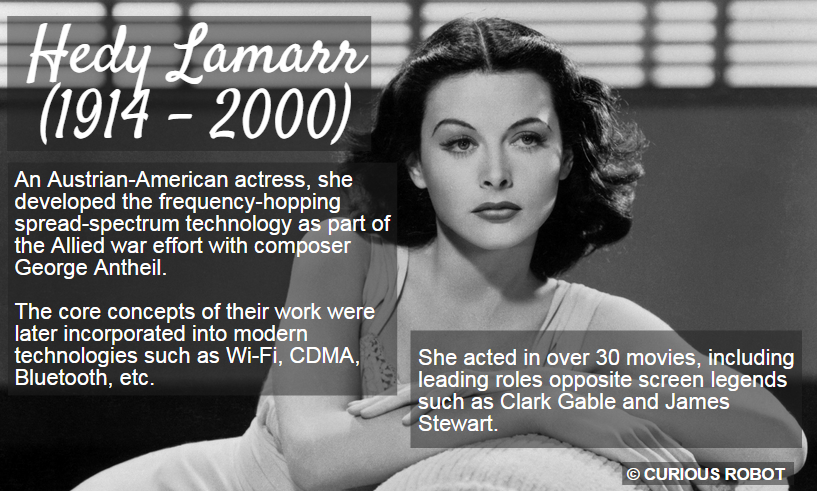By: Chris Warren.
History often takes unusual, sometimes bizarre paths back to an origin, and the farther back something happened, the less known the strange details are. For example: Ask 100 people on the street who Hedy Lamarr was and it would be surprising if even one gives a correct answer. Here’s the kicker: Hedy Lamarr invented something in 1942 that the average person today uses all the time and carries with them everywhere they go.
Hedy Lamarr was about as far from the image of a technical innovator and inventor as one could expect. As a hugely popular actress in the 1930’s and 40’s, she graced movie screens with the likes of Spencer Tracy and Clark Gabel. With such a busy filming schedule, it’s amazing that she had time to dabble in science. Yet dabble she did, and in what might have been one of those Hollywood-esque eureka! moments, Hedy Lamar invented what is now known as spread spectrum frequency transmission.
I know…I can sense my readers’ eyes glazing over. Stay with me a little longer and don’t click away from this page. Lamarr’s invention and personality is relevant to your modern life in ways you may not realize. Much more than someone who both starred in movies and changed the world with her invention, Hedy Lamarr tells a personal story that goes deeper than art and science.
It is very easy to interfere with a transmitter that sits on the same frequency all the time. In World War II this had serious implications for radio communications. All the enemy had to do was find the frequency the Allies were on was on and jam it, or they could quietly eavesdrop and collect intelligence data.
But if the transmitter constantly changes frequencies, and the receiver changes with it, then the transmission is much more secure because it never stays on any one channel for very long. It would be impossible for the enemy to follow the constant changes.
That’s basically how spread spectrum frequency transmission works. Hedy Lamarr, along with a musician neighbor, came up with a device that used something similar to paper piano rolls to change the frequencies. As long as both the transmitter and receiver had copies of the same roll, and the rolls were running exactly in sync, the system would work. The paper rolls were a 1940’s version of “software.” Lamarr was granted a patent on August 11, 1942.
As things went, the US Navy took a pass on Hedy Lamarr’s invention until 1962 when the Cuban Missile Crisis forced the American military to up their technological game. By then the patent had expired but Lamarr’s legacy was secure. Today, cellphones, wifi, Bluetooth, remote controlled devices, security alarms, public safety communications systems…almost everything wireless uses some form of spread spectrum. The frequency hopping is controlled by computers instead of paper rolls and occurs thousands of times per second. The net result is less interference and more security.
Great discoveries often come from unusual origins. There are other examples out there, but a World War II era movie queen with no formal engineering credentials coming up with an invention that touches every moment of our modern lives is possibly the most profound.
Hedy Lamarr died in obscurity in 2000, just about when cellphones became an everyday item and well before Bluetooth or wifi. She did not live to see her invention come into common use, but I’ll bet a thoughtful mind like hers sensed she was on to something that was valuable for more than just avoiding the Nazis. Lamarr was posthumously inducted into the National Inventor’s Hall of Fame in 2014.
And that my friends is the offbeat story behind one of the most important technological developments of the modern age. Perhaps unintentionally, Hedy Lamarr also taught us something about weaknesses in human nature such as doubting others’ abilities based on stereotypes and not being open to ideas from unexpected sources. Hedy Lamarr is living proof that greatness often comes from the direction we are not looking.

